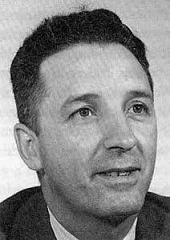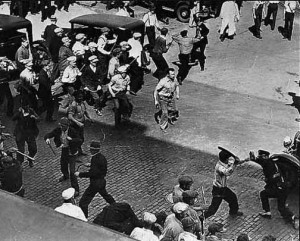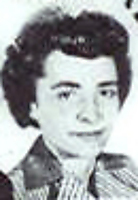 Farrell Dobbs, the Socialist Workers Party candidate for President, predicted that Republican Thomas E. Dewey would capture the White House on this day in 1948. Dewey was leading President Truman by double digits in most public opinion polls at the time.
Farrell Dobbs, the Socialist Workers Party candidate for President, predicted that Republican Thomas E. Dewey would capture the White House on this day in 1948. Dewey was leading President Truman by double digits in most public opinion polls at the time.
Speaking at a press conference in Pittsburgh, the soft-spoken Dobbs, conceding that his own Trotskyist party didn’t have a snowball’s chance of winning the presidency, also predicted that the country would undergo a major political realignment after Dewey’s victory, resulting in the virtual disintegration of the Democratic Party. The Democrats, of course, were already feeling the strain of a possible double rupture by virtue of former Vice President Henry A. Wallace’s Progressive Party candidacy on the left, as well as the Dixiecrat candidacy of South Carolina’s J. Strom Thurmond on the party’s right.
Embarking on the first of four consecutive bids for the nation’s highest office five weeks earlier in Seattle where he lent his party’s support to striking Boeing workers, Dobbs, the son of a coal miner, first gained national attention for his role in the historic Minneapolis Teamsters strike in 1934 — a work stoppage described as “one of the greatest labor battles in U.S. history.”
Involving not only rank-and-file truck drivers and warehouse workers but thousands of other Minneapolis workers who joined in solidarity, the 1934 Teamster Rebellion, transforming the 75,000-member Teamsters from a craft union to a kind of industrial union while laying the foundation for a strong union tradition across the Midwest, helped launch a four-year surge in industrial unionism in the United States.
Given his experience in the Minneapolis strike, it wasn’t surprising that Dobbs, who left the American Federation of Labor nine years earlier to devote all of his time and energy to politics — serving as editor of The Militant, the party’s newspaper, from 1943-48 and as the party’s national chairman and national secretary for the next quarter century — spent much of the 1948 campaign on the picket line, joining striking workers in various industries who were fighting for higher wages and better working conditions.
In October, the SWP held two rousing street meetings on the San Francisco waterfront where the 41-year-old Dobbs addressed approximately 600 striking longshoremen and other shipyard workers. “Bring up that strong left arm of independent political action to match your strong right of economic action,” he exhorted the maritime strikers. “Away with company-unionism in politics. Form your own party, based on the trade unions and take the power away from the corrupt boss parties.”
 Described by Teamsters President Jimmy Hoffa as “the architect of the tactics” that created the modern Teamsters union, the former truck driver and ex-Teamster official was joined on the Socialist Workers Party’s ticket that year by Dr. Grace Carlson, a former psychology professor and university lecturer-turned-party organizer from Minneapolis.
Described by Teamsters President Jimmy Hoffa as “the architect of the tactics” that created the modern Teamsters union, the former truck driver and ex-Teamster official was joined on the Socialist Workers Party’s ticket that year by Dr. Grace Carlson, a former psychology professor and university lecturer-turned-party organizer from Minneapolis.
Like Dobbs, Carlson had been among the eighteen Trotskyists convicted of violating the notorious Smith Act in 1941, making it a federal crime to advocate the overthrow of the U.S. government, and served a sixteen-month stint in federal prison. She had also been an antiwar candidate for the U.S. Senate on the party’s ticket in 1940, shortly after joining the Socialist Workers Party.
Carlson, who earned only thirty dollars a week as a party organizer — often relying on the generosity of party members to provide her groceries and other basic necessities— long maintained that she had merely “predicted violence in the change-over from a capitalist to a socialist form of government,” adding that “there is a considerable legal gap between predicting and advocating.”
Denouncing the two major parties and Henry Wallace’s Progressive Party as representatives of “decaying capitalism” the SWP called for government ownership of all basic industries, including nationalization of the banking industry, a ban on commodity speculation, a six-hour workday and a thirty-hour week, repeal of the Taft-Hartley Act and other laws hostile to organized labor, and withdrawal of all U.S. troops from foreign soil.
Among other things, the party also called for an end to segregation and the complete eradication of Jim Crow laws. The party also pushed for fair ballot access laws and lowering the voting age to eighteen.
Appearing on the ballot in eleven states — Colorado, Connecticut, Iowa, Michigan, Minnesota, New Jersey, New York, Pennsylvania, Utah, Washington and Wisconsin — and waging write-in efforts in California, Ohio and elsewhere, the Dobbs-Carlson ticket garnered 13,614 votes nationally during the party’s inaugural presidential campaign in 1948.

Myra Tanner Weiss, who ran for vice president on the party’s ticket in 1952, 1956 and 1960, garnered 1,013 votes, or nearly one percent, in an unsuccessful bid for Congress on the party’s ticket in 1948.
In addition to the Dobbs-Carlson ticket, the SWP, which traced its origins back to James P. Cannon and Max Shachtman’s Communist League of America in 1928 — an expelled faction of the Communist Party USA loyal to Leon Trotsky — fielded at least a dozen other candidates that year, including former Militant editor and author George Breitman, a founding member of the party who ran for the U.S. Senate in New Jersey.
Vincent R. Dunne, a seasoned veteran of the IWW who, along with his brothers Miles and Grant and Swedish-born socialist Carl Skoglund, worked closely with Dobbs during the bitterly-fought Minneapolis Teamsters strike, also campaigned on the party’s ticket as a candidate for the U.S. Senate from Minnesota.
The fashionably-dressed Myra Tanner Weiss of Los Angeles, the daughter of a wealthy investment banker who ran for Congress in California’s 19th congressional district, also appeared on the party’s ticket that autumn. Weiss, who waged two quixotic campaigns for mayor of Los Angeles — losing badly in 1945 and again in 1949 — later served as Dobbs’ vice-presidential co-star in the 1952, 1956 and 1960 presidential campaigns.



Pingback: Skull / Bones » Blog Archive » third party presidential candidate updates
1948 was the first year that the Socialist Workers Party ran a candidate for President. Within the SWP, a group in Chicago led by Arne Swabeck and, separately, the Buffalo branch of SWP led by Sam Marcy, advocated support for Henry Wallace and the Progressive Party. Apparently the Clark/Cochran tendency in New York City and Michigan advocated some form of SWP orientation toward the Progressive Party.
Marcy’s group separated from SWP some years later, forming the Workers World Party. WWP was the first pro-China faction in American Communism. Swabeck was expelled in 1967 for promoting Maoism. Despite the similar origins and similar pro-Mao stands, Swabeck and Marcy never formed an alliance. Clark and Cochran were expelled from SWP in the early 1950s.